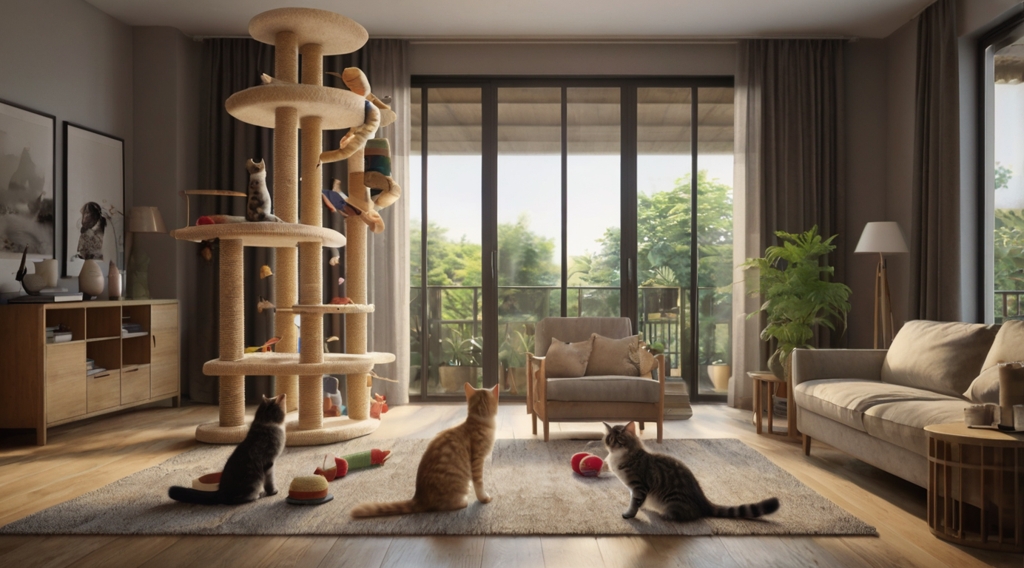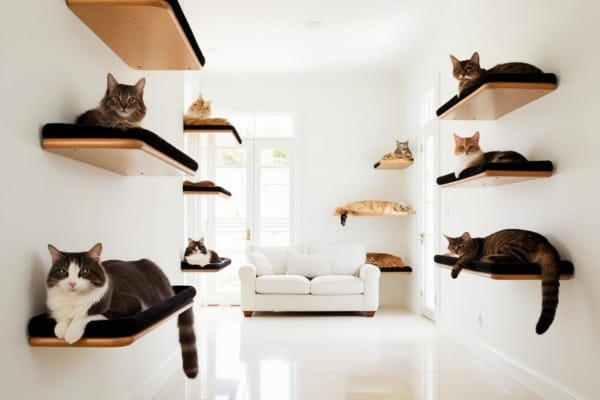
We may earn a commission when you purchase via our links at no extra cost to you.
We only share resources that meet our high standards
Cats may spend hours curled up in cozy corners, but beneath that calm exterior is a natural-born hunter. In the wild, cats climb trees, stalk prey, and explore varied landscapes. While keeping your cat indoors protects them from traffic, predators, and disease, it also limits those instinctive opportunities. Without intentional enrichment, an indoor cat’s life can become sedentary and dull — leading to weight gain, destructive behavior, or even depression.
What is a Stimulating Indoor Environment for Cats?
A stimulating indoor environment for cats combines physical, mental, and sensory activities that mimic natural behaviors like hunting, climbing, and exploring. Examples include cat trees, puzzle feeders, window perches, and interactive play sessions, all arranged safely and rotated regularly to keep your cat engaged and healthy.
Key Takeaways
- Enrichment prevents boredom and behavioral issues in indoor cats.
- Variety is key — mix physical, mental, and sensory activities.
- Rotate toys and activities every few days to keep things fresh.
- Provide safe climbing and scratching areas to meet natural needs.
- Bonding time matters as much as toys and equipment.
Why Indoor Cats Need Environmental Stimulation
Cats are both predators and prey in the wild. This dual role has shaped their instincts: they need to hunt, climb to safety, hide, and explore.
Without enrichment, indoor cats may:
- Scratch furniture or carpets out of frustration.
- Overeat from boredom, leading to obesity.
- Develop anxiety-related behaviors, such as overgrooming.
- Sleep excessively without enough active play.
According to the American Veterinary Medical Association, enriched indoor environments can extend a cat’s healthy lifespan by reducing stress and increasing activity levels.
Core Principles of Cat Enrichment
- Variety Matters – Mix physical, mental, and sensory challenges. A cat who only has one type of toy will quickly lose interest.
- Safety First – Avoid small parts that can be swallowed, and ensure heavy structures are stable.
- Rotate Often – Introduce “new” experiences weekly by moving furniture, changing toys, or adding new scents.
- Respect Individual Preferences – Not all cats love climbing or noisy toys; adapt to their personality.
- Balance Activity with Rest – A cozy hiding spot is as important as an active play area.
Physical Enrichment Ideas

Climbing Structures & Vertical Spaces
Cats naturally seek high vantage points. Install multi-level cat trees, wall-mounted shelves, or even window hammocks. For more ideas, see our cozy catio idea.
Scratching Stations
Offer different textures — sisal for durability, cardboard for satisfying shredding, and carpet for variety. Place them in high-traffic areas, not hidden in corners, to encourage use.
DIY Obstacle Courses
Use tunnels, step stools, and cardboard boxes to create a “play circuit.” Rearrange it weekly to maintain novelty.

Mental Stimulation Activities
Puzzle Feeders
These transform mealtime into a problem-solving activity. Start with easy designs like a treat ball, then progress to multi-step puzzles.
Interactive Play
Wand toys, feather teasers, and motorized mice mimic hunting. Engage in short, daily sessions — cats prefer several 5–10 minute hunts over one long playtime.

Trick Training
Yes, cats can learn tricks. Simple commands like “sit,” “high five,” or “come” not only stimulate their brains but also strengthen your bond. Use treats and a clicker for best results.
For more toy ideas, explore Amazon best interactive cat toys.
Sensory Experiences for Indoor Cats
Visual Stimulation
Set up a perch near a bird feeder or aquarium. The movement outside keeps cats engaged, even without physical interaction.

AMOSIJOY Cordless Cat Window Perch
This cat window perch is upgraded with thickened fluffy cushion bed cover, which give cats more comfort and safety while sleeping on it
Scent Enrichment
Catnip, silver vine, and valerian root can trigger playful bursts. Rotate scents so your cat doesn’t get bored.
Soundscapes
Nature sounds or even leaving a TV channel with animal programming can offer background enrichment when you’re not home.
Also consider adding cat-safe houseplants for extra sensory variety.

Social Enrichment & Interaction
Scheduled Playtime
Cats thrive on routine. Set aside specific times each day for play, grooming, or cuddle sessions.
Solo Entertainment
Cats thrive on routine. Set aside specific times each day for play, grooming, or cuddle sessions.

Interactive Cat Toys – Moving Concealed Feathers

Interactive Cat Toys Ball

Interactive Cat Toys – Cat Laser Toys
Multi-Cat Dynamics
Offer multiple food, water, and litter box stations to reduce competition and stress. Cats are territorial, and a well-planned home layout prevents conflicts.
Advanced Enrichment Ideas
- Catios & Outdoor Enclosures – A screened patio lets cats enjoy fresh air and sunlight without risk.
- Leash Training – Some cats adapt to harness walking, giving them safe outdoor exploration.
- Seasonal Decor Changes – Rotate furniture or add themed toys to keep the environment interesting.
The VCA Hospitals feline enrichment guide recommends combining indoor and outdoor-safe setups where possible.

Interactive Indoor Cat Tree
Multi-level structure is designed for more than one cat to play at the same time. Padded plush perches provide a cozy place to rest; sisal rope coiled posts and scratching ladders help encourage scratching behavior
Common Mistakes in Cat Enrichment
- Overcrowding Spaces – Too much clutter can stress cats. Keep enrichment areas accessible but not overwhelming.
- Neglecting Hideaways – Cats need private, safe spots to retreat and rest.
- Unsafe Plants & Decor – Avoid lilies, philodendrons, and other toxic plants.
Conclusion
An enriched indoor environment is more than just entertainment — it’s a necessity for a cat’s physical and mental well-being. With a mix of climbing spaces, puzzle toys, sensory stimulation, and consistent interaction, you can create a home that satisfies your cat’s instincts while keeping them safe.
You can start from small move, maybe a new perch by the window or a short daily play session. Over time, you’ll see a healthier, happier cat who thrives indoors.





